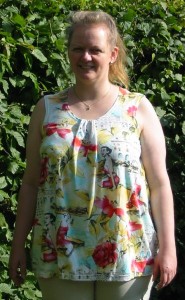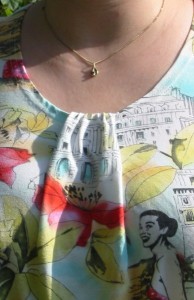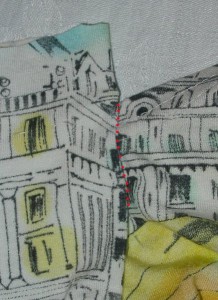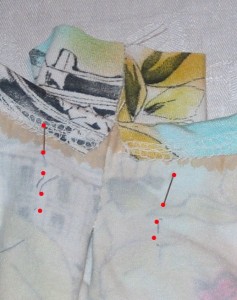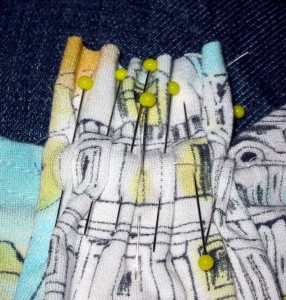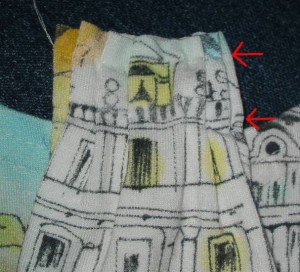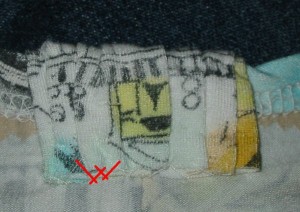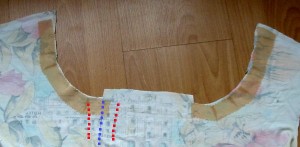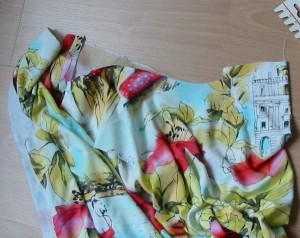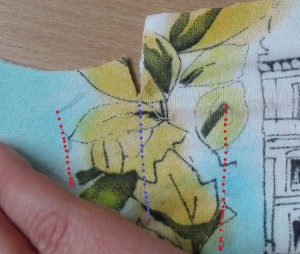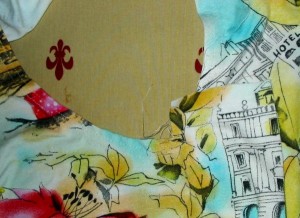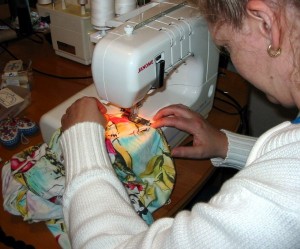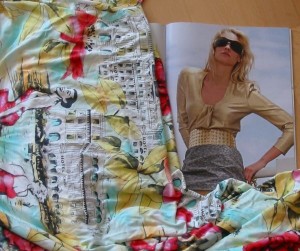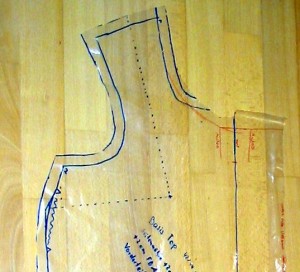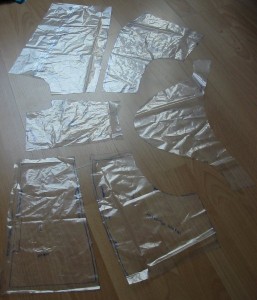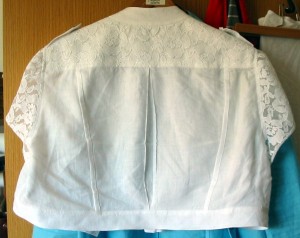Ein neuer Motivationsmonat steht an. So wie es aussieht wird das Thema “Cape und wärmende Hüllen” sein.
Wir haben August, es ist (endlich) heiß hier, schwül dazu. Perfekt, um warme Stoffe um sich zu drapieren.
Wir erinnern uns… warum wollte ich dieses Jahr an den Motivationsmonaten teilnehmen? In erster Linie wollte ich meine Stofftruhe mal etwas entlasten. Dann wollte ich meinen Kleiderschrank auffüllen, denn bei meinem bisherigen Nähtempo entstanden doch immer wieder Lücken. Weiterhin hoffte ich auf die Gelegenheit, länger gehegte, aber immer zurückgestellte Projekte zu verwirklichen. Und ein bißchen Herausforderung durch Themen die mir nicht so liegen ist ja auch nicht schlecht…
Das mit dem Stoffabbau hat nur mäßig gut geklappt… Im Januar war es ein Schlafanzug, in großes Stück Stoff aus meinem Fundus, kein sehr dicker allerdings.(Dafür war der Pyjama dringend nötig und ein lange gehegtes Projekt.) Auch das Shirt im Februar entstammte meiner Kiste. Die Jeans im März war zwar dringend gebraucht, aber dafür mußte ich Stoff kaufen. Auch im April (Oberteile mit Kapuze) war Stoffkauf angesagt. Immerhin einer, den ich schon länger für genau diese Jacke im Auge gehabt hatte. (Aber ein dicker, die Restekiste quilt auch immer mehr über.) Der Mai war perfekt: ein abgelagertes Stöffchen UND ein Schnitt der dafür schon länger bereit lag. Allerdings ein sehr dünner Stoff. Und es ist noch was übrig. Auch im Juni wurde das Kleid aus einem vorhendenen Jersey genäht. Allerdings konnte ich mich für den Kontraststoff nicht entscheiden, daß ich davon so viele verschiedene gekauft habe, daß die Stoffkiste jetzt voller ist als zuvor und noch zwei Stoffe rumliegen (unauffällig bei der Bügelwäsche…), die auch beim besten Willen nicht mehr reinpassen. 🙁 Da hilft auch das Juli Sommertop nicht weiter.
A new “Motivationsmonat”… The theme will be “Capes and warming shells”.
It’s august, it’s (finally) hot plus humid. Perfect time to play around with warm fabrics…
So, what was it, why I wanted to take part in the sew along? First idea was to reduce my stash. Next goal was filling my wardrobe, because I was always sewing so slow, that I was always in the need of something. Then there was the hope it would make me realise project I was having in my mind for quite a long time, but came always second (and therefore never were executed). And a bit of challenge with topic that are beyond my comfort zone isn’t bad either.
Reducing my stash did not really work out. In january it was sleepwear, a big piece of cotton from my stash but not a thick one. (On the other hand it was something I really needed and also a project I had wanted to do for about two years.) Also the february top came from my stash. (Another thin fabric…) Jeans in March were something I had been needing urgently, but I had to by fabric. Same for April: new fabric. Not even needed. But a project I had wanted to do since I had seen the fabric in the shop. (Now my stash of remenants is overgrowing, it was a very thick knit.) May was perfect: Fabric I already had and a pattern I had planned to use for that fabric for quite a while. But a think silk and there is still something left. June-dress was sewn from stash also, but I couldn’t decide waht to take for tha contrast and bought therefore so many different fabrics for that, that my box now is fuller than in January. (And there are two more fabrics that do not fit in there, well hidden under the pile for ironing… *g*) So the bit of fabric the summer top in July used up didn’t help. (Plus again there is more left than I’ve used…)
Ein Element meiner Wunschliste ist allerdings noch nicht aufgetaucht: Die Herausforderung. Bisher passte alles gut in meine Pläne.
One element from my “why I want to take part” list didn’t show up so far: The challenge. So fareverything could be fitted in my plans easily.
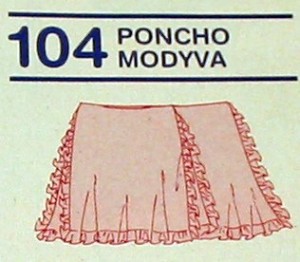 Mit dem Thema Cape hingegen mußte ich mich jetzt erst mal intensiv befassen.
Mit dem Thema Cape hingegen mußte ich mich jetzt erst mal intensiv befassen.
Ich habe mir also alle meine Hefte geschnappt und mal alles rausgezogen, was auch nur im entferntesten Ähnlichkeit mit einem Cape hat.
Das erste Modell kommt aus der Patrones 217 vom Februar 2004. Ein Cape aus Chiffon mit Rüschen. Also es ist eigentlich ein Poncho, aber ein Cape ist ja so was ähnliches wie ein Poncho…
Vorteil wäre, das ich nicht mit dickem, warmem Stoff hantieren muß.
Nachteil ist, daß ich vermutlich keinen passenden Stoff dafür habe und mir auch keine rechte Gelegenheit einfällt, zu der ich so was tragen könnte. Und bei genauer Betrachtung… ich fürchte das Ding gefällt mir nicht mal. Schon gar nicht mit den Rüschn.
“Cape” on the contrary is a topic I’ll take some time to accomodate… Especially in August, when it is hot.
So I started searching my collectin of pattern magazines, picking everything that is at least a bit cape-like.
My first model is from Patrones 217, Fabruary 2004. It’s a chiffon-cape with ruffles. Okay, it’s a poncho, but a pomcho is nearly a cape, isn’t it?
Advantage: No thick and warm fabric to handle in the heat.
Disadvantage: I don’t thick I hae a fabric for that in my stash. Also I cannot think of an occasion to wear it. And if a take a closer look.. I guess I don’t want to wear that. The ruffles are so much not for me…
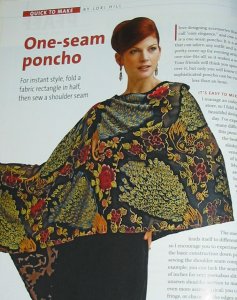 Das nächste Modell wäre ein Bewährtes, der Poncho aus Threads 127 (November 2006).
Das nächste Modell wäre ein Bewährtes, der Poncho aus Threads 127 (November 2006).
Ich habe ihn schon zwei Mal genäht und da man dafür eine der Länge nach geteilte Stoffbahn braucht, hätte ich auch noch Stoff. Allerdings Stoff, der mir nicht steht, weil ich das Modell ja für andere genäht habe.
Der Vorteil wäre: es geht schnell zu nähen…
Next model is a poncho again, from Threads 127 (november 2006)
I’ve already made two versions of that and as you have to cut your fabric in half lenthwise I still do habe the second halves. But I made it as gifts and none of the fabrics is my colour.
But it would be a quick project, which would let my plenty of time for other (more usefull) prjects this months…
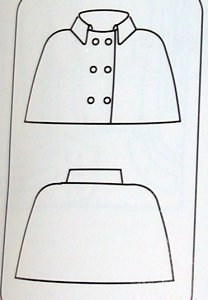 In der f.i.m.i. war im Winter 2006 diese Pelerine drin. Also ein Minicape, das nur die Schultern bedeckt.
In der f.i.m.i. war im Winter 2006 diese Pelerine drin. Also ein Minicape, das nur die Schultern bedeckt.
Vorteile: es geht bis Größe XL, ich kann dicken Stoff verwenden, der meine Truhe etwas entlastet und es ist klein genug, um im Kleiderschrank hinterher nicht allzuviel Platz wegzunehmen. Dafür könnte ich mich vielleicht mit irgendeinem Embellishement austoben?
Allerdings sehe ich mich so etwas nicht wirklich tragen. Einmal mangels Gelegenheit (wenn ich die Schultern warm haben will, dann normalerweise auch den Rest) und zum anderen, weil ich keine Vorstellung habe, wie das an mir aussehen könnte…?
Th Dutch f.i.m.i. had this shoulder covering mini-cape in the winter 2006 issue.
It goes up to size XL and I could use one of my thick woolen fabrics from my stash which would unburden my fabric trunk a bit. And the result would be small enoght not to block too much space in my wardrobe. And I could use it to try some weird embellishment…?
On the other hand I don’t see me really wearing this. First because I son’t see an occation. If it is so cold, that I want to cover my shoulders, I usually want to cover other parts of my body as well. And I don’t have any idea, how that might look on me…?
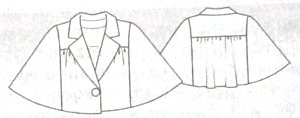 Diese süße Pelerine war im September 2007 in Burda.
Diese süße Pelerine war im September 2007 in Burda.
Allerdings nur bis Größe 42, was schon mal den halben Spaß verdirbt.
Ansonsten sind die Vor- und Nachteile ähnlich dem f.i.m.i. Modell. Er ist vielleicht ein bißchen länger und wärmt deswegen etwas mehr.
BWOF came up with this version of a tippet (is that the word?) int the september 2007 issue.
But only up to size 42, which would already make it quite tedious to change the pattern.
Apart from that the pros and cons are quite similar to the model above. The BWOF Version might be a bit longer, and therefore warming a bit more of the body.
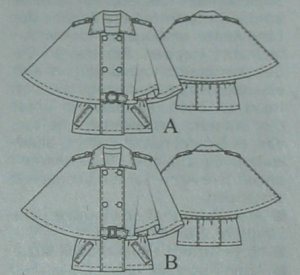 Wirklich gut gefallen hat mir schon beim Erscheinen dises Modell aus der Burda vom August 2007.
Wirklich gut gefallen hat mir schon beim Erscheinen dises Modell aus der Burda vom August 2007.
Das Problem ‘Wann tragen?’ bleibt auch hier, denn zur Arbeit trage ich meinen Laptop meist im Rucksack und da paßt nicht wirklich ein Cape drüber, wenn man nicht wie der Glöckner von Notre-Dame aussehen will. Das zweite Problem ist der Stoff, denn dafür kann ich mir nur eine Popeline (wie für einen Trenchcoat) vorstellen oder einen anderen Stoff für Wettermäntel. Und so etwas habe ich definitiv nicht in meinem Vorrat.
Zudem sieht es nach einem sehr aufwendigen Projekt aus, was nicht besser wird dadurch, daß auch dieser Schnitt in Größe 42 endet… (Der Arbeitsaufwand ist diesen Monat mal wieder ein Argument, denn zuerst kommt meine Mami eine knappe Woche, dann besuchen wir Freunde, die ein bißchen weiter weg wohnen und nach Paris geht es auch noch. Und irgendwo dazwischen muß ich ja auch noch Geld verdienen…)
What I really loved the moment it came out is this model from BWOF august 2007.
The “‘For what occasion can I wear that?’ problem remains. Because when I go out to work I carry my laptop in a backpack and a cape doesn’t fit over it. (Unless you plan to look like the hunchback of Notre-Dame. The second problem is that I see this model in a popeline or another raincoat like fabric. Which is something I definitely do not have in my stash.
Also it looks like a time consuming project, which doesn’t get better by the fact that Burda “allowes” this pattern again only up to size 42. (Time again is an issue this month. first my mother comes to see me for nearly a week, the we will visit friends who live a bit further away and also Paris is on this months schedule. And in between all that I have to earn some money,,,,)
 Und dann wäre da natürlich das Modell aus der aktuellen Burda. Es geht immerhin bis Größe 46 und hat auch eine vernünftige Länge.
Und dann wäre da natürlich das Modell aus der aktuellen Burda. Es geht immerhin bis Größe 46 und hat auch eine vernünftige Länge.
Allerdings… wie schon gesagt… Cape und Rucksack paßt nicht so gut. Und erwähnte ich es schon? Ich habe schon ein Wintercape, aus schöner Wolle. Das hält vermutlich noch ewig… Zumal ich es selten trage…
I did not forget the cape from this months BWOF. It is even up to size 46 and it has a good length to keep you warm.
If you do not wear backpacks, as I’ve mentionned above. And did I tell? I already have a cape. Made from a good, stabile woolen fabric. Which probabely never will wear out. Especially as I can only wear it rarely…
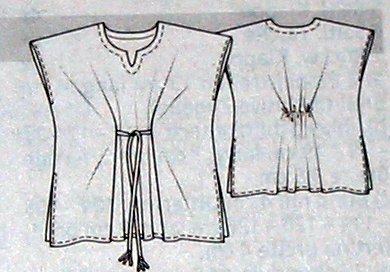 Ja und dann fiel mir noch diese Tunika auf, sie ist aus dem Maiheft 2006.
Ja und dann fiel mir noch diese Tunika auf, sie ist aus dem Maiheft 2006.
Wenn man den Schnitt genau anguckt… eigentlich ist es ein Poncho mit zusammengenähten Seiten. Und ein Poncho ist ja fast so was wie ein Cape…
Vorteil ist, es ist ein vermaßter Schnitt, also nicht sehr schwierg anzupasse. Außerdem aus dem Spektrum der Plus-Größern. Irgendeinen Baumwollstoff in passender Menge sollte noch vorhanden sein. Ich muß nicht bei Hitze mti dicker Wolle hantieren. Und wenn es als Tunika doof aussieht… dann kann ich gut noch ein Nachthemd brauchen… *g*
Allerdings frage ich mich, ob das nicht sehr am Thema vorbeigemogelt wäre?
Finally I noticed this tunic from BWOF May 2006.
If you look at the pattern… technically it’s a poncho with side seams. And a poncho is practically the same as a cape…
It would not be difficult to fit that pattern, as it does not seen to have a very precise fit. Also it is a plus pattern. I should have some cotton, big enough for this and I do not have to handle warm woolen fabric in a hot month. And if it looks stupid as a tunic…. I can do with some more nightwear…
But I’m not sure, whether that would not be a bit too far from the topic…?
Nun ja, als nächstes muß ich mal meine Stofftruhe ausräumen und mal gucken, was so passen könnte… Kommentare und Vorschläge zu den Schnitten und dem Thema sind derweil höchstwillkommen…
Well, next thing will be diving into my fabric stash and see what might match any of the patterns. Meanwhile comments and suggestions are highly welcome…

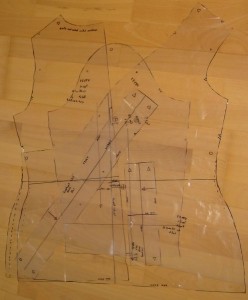
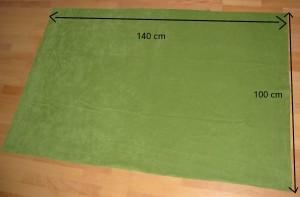
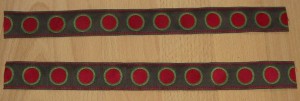
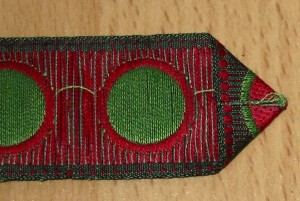
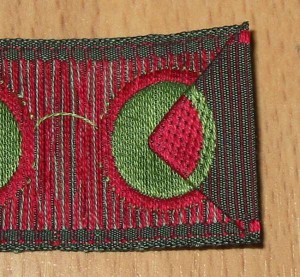

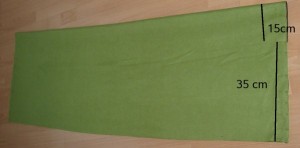
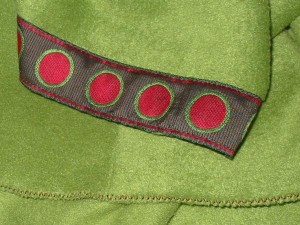
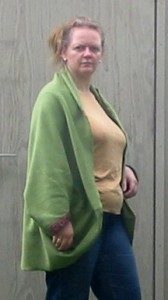

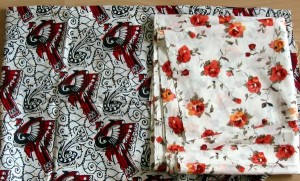
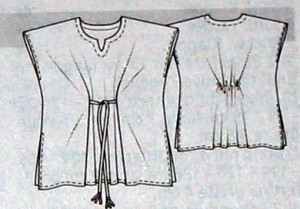
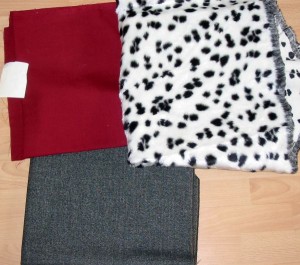
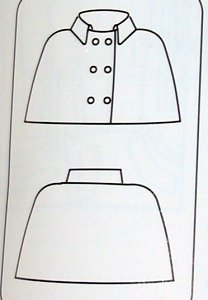






 Ja und dann fiel mir noch diese Tunika auf, sie ist aus dem Maiheft 2006.
Ja und dann fiel mir noch diese Tunika auf, sie ist aus dem Maiheft 2006.